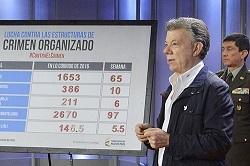Colombia’s seizure of a record amount of cocaine in 2016 is likely a reflection of criminal groups’ ability to boost drug production year upon year despite the government’s constant efforts to fight both production and trafficking.
President Juan Manuel Santos announced on June 14 that 146.5 metric tons of cocaine have been seized in the country during the first five and a half months of 2016 — an average of about 6 metric tons per week.
“Never before … in all the decades we’ve spent fighting drug trafficking, has so much cocaine been seized by security forces,” Santos said during his weekly security briefing.
That figure represents a slight improvement over the 295 metric tons of cocaine hydrochloride and cocaine base seized during all of 2015, according to US State Department figures.
SEE ALSO: Cocaine Production Coverage
So far in 2016 authorities have destroyed 2,670 drug processing laboratories, while 1,653 members of criminal organizations have been “neutralized” — arrested, killed, or surrendered — Santos added. Last week police killed two regional commanders of the Urabeños, the largest of the country’s neo-paramilitary groups (known in Spanish as bandas criminales – BACRIM).
Santos said authorities have also carried out 386 operations against illegal mining this year, destroying 211 pieces of heavy machinery. He said the national homicide rate was 25.9 per 100,000 over the past 12 months, the lowest in 40 years.
InSight Crime Analysis
As is usually the case with seizure statistics, it is hard to tell whether Colombia’s record figures indicate improving interdiction efforts or rising drug production. However, there have been growing indications over the past two years that Colombia’s cocaine trade is soaring.
In 2015 the country reclaimed its title as the world’s number one coca cultivator, with hectares under coca cultivation growing to their highest level since 2007. This increase has been attributed to the Revolutionary Armed Forces of Colombia (Fuerzas Armadas Revolucionarias de Colombia – FARC) encouraging coca farmers to plant more crops as they prepare to demobilize, as well as more lenient eradication policies.
SEE ALSO: Coca Coverage
Meanwhile, Colombia’s main criminal groups continue to defy authorities by coordinating huge drug shipments and expanding into strategic drug trafficking territories.
Security forces are thought to seize about a tenth of a country’s total illegal drug flow, which suggests that Colombia’s yearly cocaine output could be even higher than estimated. The US government estimated Colombia’s 2015 potential cocaine production at 420 metric tons, while the latest United Nations Office on Drugs and Crime (UNODC) figures available estimated (pdf) world cocaine production at between 700 and 1,000 metric tons a year from 1990 to 2008.

